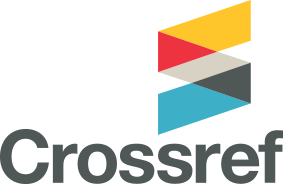PENGGUNAAN TEPUNG IKAN DALAM PAKAN KONSENTRAT DAN PENGARUHNYA TERHADAP PERTAMBAHAN BOBOT BADAN KAMBING BETINA
Abstract
Enam belas ekor kambing betina tidak bunting digunakan untuk
mengevaluasi pengaruh penggunaan tepung ikan dalam pakan konsentrat dan
pengaruhnya terhadap konsumsi pakan dan efisiensinya. Kambing tersebut
dikelompokkan menjadi empat kelompok berdasarkan bobot badan awal dan
diberi pakan konsentrat sebagai perlakuan, yaitu konsentrat A yang mengandung
4,5% bungkil kedele dan 1,5% urea, dan konsentrat B, C, and D mengandung 5,
10, dan 15% tepung ikan. Masing-masing kambing diberi konsentrat sesuai
dengan perlakuan sebanyak 1,5% dari bobot badan dan rumput gajah secara ad
libitum hingga total pemberian pakan dalam bentuk bahan kering mencapai 3%
dari bobot badan.
Hasil penelitian menunjukkan bahwa penggunaan tepung ikan dalam
konsentrat dapat meningkatkan palatabilitas konsentrat, konsumsi pakan,
kecernaan pakan, N-retensi, and berat badan. Kambing yang diberi konsentrat B,
C, dan D menunjukkan konsumsi pakan lebih tinggi dibanding pemberian
konsentrat A (P>0,05). Pemberian konsentrat C menunjukkan konsumsi pakan,
efisiensi pakan, dan pertambahan bobot badan lebih tinggi dibanding pemberian
konsentrat B dan C (P>0,05).
Berdasarkan hasil penelitian tersebut dapat disimpulkan bahwa tepung
ikan dapat digunakan sebagai salah satu bahan penyusun konsentrat pada ternak
ruminansia untuk meningkatkan efisiensi pakan dan pertambahan bobot badan,
dengan tingkat penggunaan optimal sebanyak 10%.
Kata kunci: tepung ikan, konsumsi pakan, efisiensi pakan, kambing
UTILIZATION OF FISHMEAL IN THE CONCENTRATE AND ITS
EFFECT ON DAILY WEIGHT GAIN OF FEMALE GOATS
Abstract
Sixteen adult unpregnant does were divided into four groups to evaluate the
effect of feeding fishmeal in concentrate on feed intake and its efficiency. The
does were given different concentrate as treatment, i.e. concentrate A containing
4.5% soy bean meal and 1.5% urea, and concentrate B, C, and D containing 5, 10,
and 15% fishmeal, respectively, at level of 1.5% of body weight. In addition,
adlibitum elephant grass to reach a total of feed dry matter offered at minimum of3.0% of body weight and drinking water were given to each doe. The results
showed that the use of fishmeal in concentrate improve palatability of the
concentrate, feed intake and its efficiency including digestibility, N-retention, and
daily weight gain for does. Does fed on concentrate B,C, and D showed better
feed intake and efficiency than does fed on concentrate A (P>0.05). While does
fed on concentrate C showed the lowest feed intake with moderate concentrate
and forage DM ratio, higher feed efficiency and body weight gain than does fed
on concentrate B and D (P>0.05). It was concluded that fish meal can be used as
one of feed component in concentrate feed for ruminant (goat) to improve feed
efficiency and body weight gain, with the most optimal of use of 10 % in the
concentrate feed.
Key words: fish meal, feed intake, feed efficiency, does
mengevaluasi pengaruh penggunaan tepung ikan dalam pakan konsentrat dan
pengaruhnya terhadap konsumsi pakan dan efisiensinya. Kambing tersebut
dikelompokkan menjadi empat kelompok berdasarkan bobot badan awal dan
diberi pakan konsentrat sebagai perlakuan, yaitu konsentrat A yang mengandung
4,5% bungkil kedele dan 1,5% urea, dan konsentrat B, C, and D mengandung 5,
10, dan 15% tepung ikan. Masing-masing kambing diberi konsentrat sesuai
dengan perlakuan sebanyak 1,5% dari bobot badan dan rumput gajah secara ad
libitum hingga total pemberian pakan dalam bentuk bahan kering mencapai 3%
dari bobot badan.
Hasil penelitian menunjukkan bahwa penggunaan tepung ikan dalam
konsentrat dapat meningkatkan palatabilitas konsentrat, konsumsi pakan,
kecernaan pakan, N-retensi, and berat badan. Kambing yang diberi konsentrat B,
C, dan D menunjukkan konsumsi pakan lebih tinggi dibanding pemberian
konsentrat A (P>0,05). Pemberian konsentrat C menunjukkan konsumsi pakan,
efisiensi pakan, dan pertambahan bobot badan lebih tinggi dibanding pemberian
konsentrat B dan C (P>0,05).
Berdasarkan hasil penelitian tersebut dapat disimpulkan bahwa tepung
ikan dapat digunakan sebagai salah satu bahan penyusun konsentrat pada ternak
ruminansia untuk meningkatkan efisiensi pakan dan pertambahan bobot badan,
dengan tingkat penggunaan optimal sebanyak 10%.
Kata kunci: tepung ikan, konsumsi pakan, efisiensi pakan, kambing
UTILIZATION OF FISHMEAL IN THE CONCENTRATE AND ITS
EFFECT ON DAILY WEIGHT GAIN OF FEMALE GOATS
Abstract
Sixteen adult unpregnant does were divided into four groups to evaluate the
effect of feeding fishmeal in concentrate on feed intake and its efficiency. The
does were given different concentrate as treatment, i.e. concentrate A containing
4.5% soy bean meal and 1.5% urea, and concentrate B, C, and D containing 5, 10,
and 15% fishmeal, respectively, at level of 1.5% of body weight. In addition,
adlibitum elephant grass to reach a total of feed dry matter offered at minimum of3.0% of body weight and drinking water were given to each doe. The results
showed that the use of fishmeal in concentrate improve palatability of the
concentrate, feed intake and its efficiency including digestibility, N-retention, and
daily weight gain for does. Does fed on concentrate B,C, and D showed better
feed intake and efficiency than does fed on concentrate A (P>0.05). While does
fed on concentrate C showed the lowest feed intake with moderate concentrate
and forage DM ratio, higher feed efficiency and body weight gain than does fed
on concentrate B and D (P>0.05). It was concluded that fish meal can be used as
one of feed component in concentrate feed for ruminant (goat) to improve feed
efficiency and body weight gain, with the most optimal of use of 10 % in the
concentrate feed.
Key words: fish meal, feed intake, feed efficiency, does
Refbacks
- There are currently no refbacks.

This work is licensed under a Creative Commons Attribution-NonCommercial 4.0 International License.










